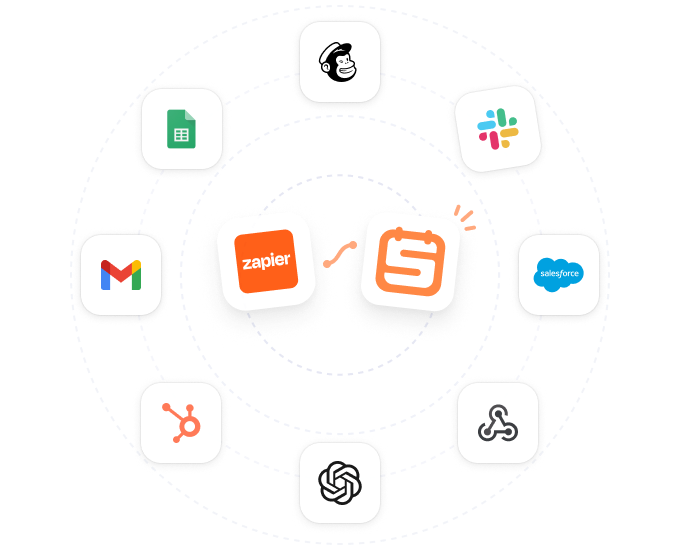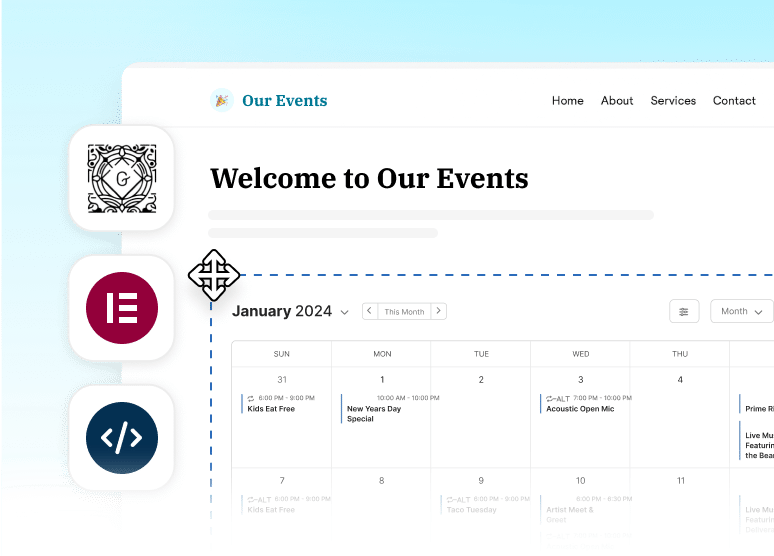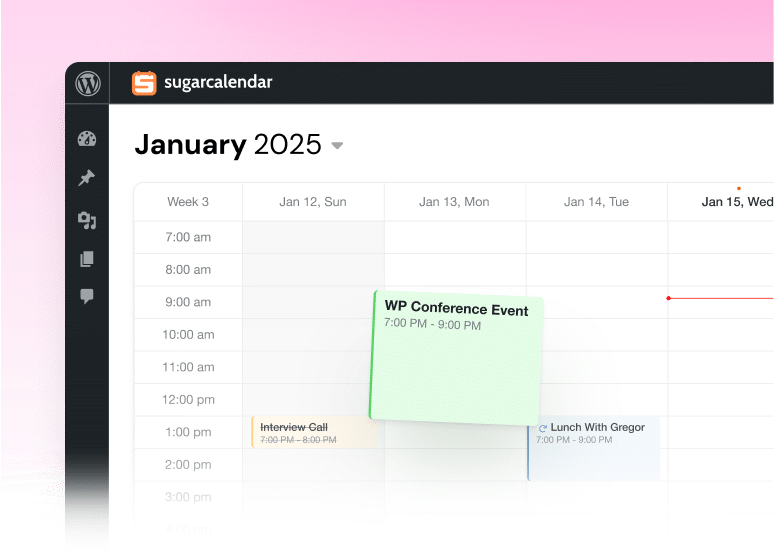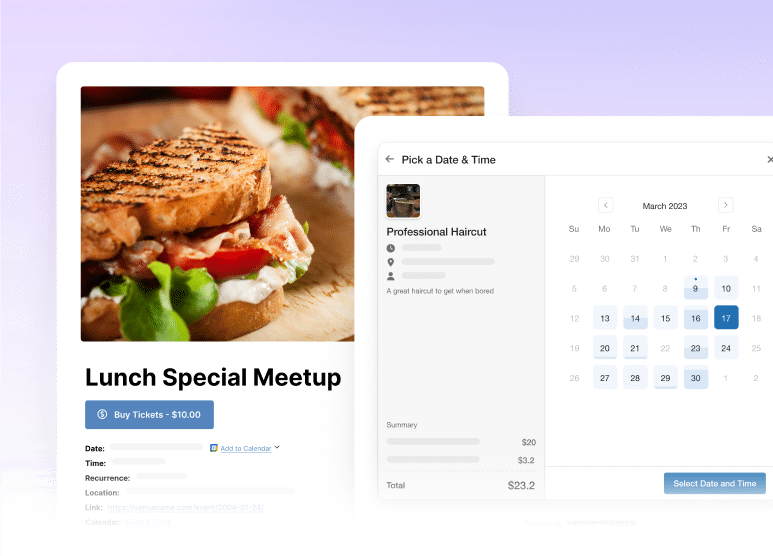WordPress Zapier integration for events
Automate everything
New attendee registers for your event? Automatically add them to Mailchimp, log them in your CRM, notify your team in Slack. Connect to 8,000+ apps without coding.

Zapier addon
Automate workflows with 8,000+ apps
Save hours every week by automating repetitive tasks. Connect Sugar Calendar to the apps you already use.
Trigger actions when events are created
Send notifications to your team in Slack, add events to Google Calendar, or update project management tools when you publish a new event.
Automate actions when tickets sell
When someone buys a ticket, add them to your CRM, subscribe them to your email list, send thank you emails, or update sales dashboards.
Track registrations automatically
When someone RSVPs or registers, add them to Mailchimp, create a row in Google Sheets, send personalized confirmations, or update your database.
Sync with email marketing tools
Connect to Mailchimp, ConvertKit, ActiveCampaign, and other email platforms. Build segmented lists based on event types, ticket purchases, or attendance.
Keep your CRM updated
Connect to Salesforce, HubSpot, Pipedrive, and more. Add attendees as leads, track event engagement, and keep all customer data synchronized.
Alert your team instantly
Get notifications in Slack, Microsoft Teams, or Discord when important things happen. Your team stays informed without checking the dashboard.
Automation for every event workflow
- Lead generation & nurturing
- Post-event follow-up sequences
- Team collaboration & notifications
- Attendee data management
- Sales pipeline tracking
- Email marketing campaigns
- Customer onboarding processes
- Reporting and analytics
- Event promotion workflows
- Registration confirmations
- Payment processing notifications
- Cross-platform data syncing
Why use the Sugar Calendar Zapier addon?
Stop doing repetitive tasks manually
Every time someone registers, you copy their email to Mailchimp. Every new event gets manually added to your team calendar. These tasks add up fast. Zapier handles them automatically so you can focus on making great events.
Keep your tools connected
Your CRM, email platform, calendar, and project management tools all need the same event data. Instead of updating each tool separately, connect them once through Zapier and they stay synchronized automatically.
Build workflows without coding
No developers needed. Zapier’s visual builder lets you create powerful automations in minutes. Choose a trigger, pick an action, and you’re done. Complex workflows become simple point-and-click tasks.
Scale your event operations
Running 10 events is manageable. Running 100 events with manual processes is chaos. Zapier automation scales effortlessly whether you host monthly meetups or daily webinars. Your systems keep up as you grow.
Explore other powerful features
Everything you need for seamless event management.

RSVP system
Track guest responses and manage attendee lists with ease.

Event ticketing
Accept payments and sell tickets directly from your WordPress site.

Form builder integrations
Create custom registration forms with WPForms, Gravity Forms, and more.
Frequently asked questions
Do you have a question about Sugar Calendar Zapier integration? See the list below for our most frequently asked questions. If your question is not listed here, then please contact us.
What is Zapier and how does it work with Sugar Calendar?
Zapier connects different apps together so they can share information automatically. When something happens in Sugar Calendar like a new ticket sale, Zapier can trigger actions in other apps like adding the customer to your email list or notifying your team in Slack. No coding required.
What triggers are available in Sugar Calendar?
Sugar Calendar offers several triggers: New Event created, New Ticket Order, New Attendee added, Event Cancelled or Deleted, and Before Event Starts. These triggers let you start workflows automatically based on what happens in your calendar.
Do I need a Zapier account to use this feature?
Yes. You’ll need both Sugar Calendar Pro and a Zapier account. Zapier offers a free plan that includes basic automations, plus paid plans with more advanced features. Sugar Calendar connects seamlessly once both accounts are set up.
Which apps can I connect to Sugar Calendar?
Over 8,000 apps work with Zapier including Gmail, Google Calendar, Mailchimp, Slack, HubSpot, Salesforce, Trello, Asana, Airtable, Google Sheets, and many more. If an app is on Zapier, you can connect it to Sugar Calendar.
How quickly do Zapier automations run?
Most Zapier workflows run within a few minutes. The exact timing depends on your Zapier plan. Paid plans offer faster update times, sometimes running in seconds. For time-sensitive workflows, consider upgrading your Zapier account.
Can I create multi-step workflows?
Absolutely. When a trigger fires in Sugar Calendar, you can set up multiple actions to happen automatically. For example, when someone buys a ticket, you could add them to Mailchimp, create a Salesforce lead, and send a Slack notification all from one workflow.
What’s a good example workflow for events?
When someone purchases a ticket in Sugar Calendar, automatically add them to a Mailchimp segment for event attendees, create a row in Google Sheets for tracking, and send a personalized welcome email. This happens instantly without any manual work.
Is the Zapier integration difficult to set up?
Not at all. Zapier’s visual builder makes it easy. You choose Sugar Calendar as your trigger app, select what event should start the workflow, then pick the action app and what it should do. Most people create their first automation in under 10 minutes.
Is Zapier integration included in Sugar Calendar Pro?
Yes. the Zapier addon is included with Sugar Calendar Plus, Pro, and Elite plans at no extra cost. You just need your own Zapier account to connect the apps. Get Sugar Calendar Pro today to start automating your event workflows.
Can I use Zapier to import events from other calendars?
Yes. You can create workflows that automatically add events to Sugar Calendar when they’re created in Google Calendar, Outlook, or other calendar apps. This keeps your calendars synchronized without manual copying.




